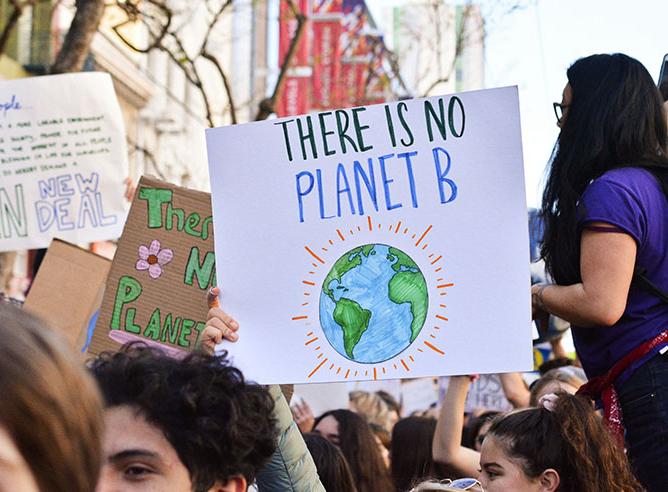The number of studies and reports on the climate is climbing, while the calls for action are growing ever louder. At the end of September, the United Nations Environment Programme (UNEP) published its “Gas Emission Report”, for the tenth consecutive year, referring to a “lost decade”. The UNEP’s experts issued a stern warning to the Paris Agreement’s 196 signatory countries, sounding their collective failure: the effort needed to limit global warming to 2°C by 2100 is now twice what it would have been if efforts to reduce emissions had been initiated from 2010. The signatory countries now need to reduce their GHG emissions by 7.6% every year from 2020 to 2030. This imperative establishes the horizon for the discussions set to take place at the 25th Global Climate Conference, COP25, in Madrid from 2 to 13 December.
The need for action is urgent and imperative. Who will step forward? The national and supranational institutions have thus far distinguished themselves by their inertia. The citizens, from the tireless hummingbirds to the tired indifferent, have but limited power. In France, their “eco-actions” can contribute to no more than 25% of greenhouse gas emissions reductions, according to the “Doing Your Part” study by the firm Carbone 4. All the rest will have to come from companies and institutions…
Cities at the vanguard of global warming
We asked Arianna De Toni (Director of the Technical Department at EcoAct), Karine Bidart (Director General of the Paris Climate Agency), Cécile Maisonneuve (President of La Fabrique de la Cité) and Thomas Lauvaux (researcher at the Laboratory of Climate and Environmental Sciences, affiliated with Penn State University) to share their views, at this second meeting in a series of talks dedicated to the environmental transition, at Leonard:Paris. Why cities? Because they are home to half of the world’s population and emit 75% of energy-related GHGs. Because the urbanisation expected between 2020 and 2050 will exceed that recorded in all of human history. Because many megacities are located in flood plains, water-scarce regions, or along coastlines. In short, cities are both the biggest contributors to global warming and the most exposed to its consequences.
In France, adds Arianna De Toni, emissions from cities account for 67% of national emissions. The top 10 cities alone account for 16% of emissions: 33% of these come from construction, 17% from industry and 16% from transport. Figures from the “The Climate Challenge of Cities” reportpublished jointly by EcoAct and WWF France. “We wanted to estimate, using the carbon emissions budget concept, what metropolises in France would need to do to comply with the Paris Agreement, also taking into account the human development indicator, which is used to weight the efforts of countries according to their level of development”. The result: “France has 10 years left to meet the 2°C target. The good news lies in the many commitments made by cities, in particular initiatives connected with C40. Note however that, according to our analysis, the efforts called for in France’s climate plans need to be doubled or tripled”, specifies Arianna De Toni.
A familiar refrain, one might say: an urgent need for action confirmed, the required efforts quantified, and the first steps eagerly awaited… Where do we stand in the implementation? “It is true that strong commitments have been made,” acknowledges Cécile Maisonneuve. However, there are also territorial marketing strategies being used, due to the competition that exists between global metropolises. In order for this competition to produce beneficial effects, a shared methodology for implementing carbon neutrality plans needs to emerge. Today’s metropolises are faced with a mile-high stack of frameworks, making it all the more difficult to compare the work carried out.For example, taking into account “Scope 3”, a calculation method that includes indirect GHG emissions, can change the emissions count of a motorway operator by a factor of 10, as it looks not only at the infrastructures’ emissions (Scope 1 and 2) but also those of users (Scope 3).
Drivers for action in metropolises
Another challenge facing metropolises is that of developing the “right” governance scope. “Typically, car travel in urban areas takes place mainly between the centre and the periphery, in other words, outside the boundaries of administrative metropolises, explains Cécile Maisonneuve. To curb the percentage of emissions generated cars, which has been stable for 40 years, metropolises – which have no authority over roads – are not necessarily the right scale of governance.”
In Paris, the Paris Climate Agency (APC) is precisely responsible for influencing players beyond the local authority’s direct scope of power. “The way in which the climate plan is implemented is certainly crucial, and it is important to understand that the public authorities have a direct effect on only about 20% of emissions. It is the remaining 80% that must needs to be secured, by mobilising inhabitants, building owners, private users, etc. says Karine Bidart. The APC carries out consultancy and support work right on the ground: advising building co-owners on the insulation and renovation of heating equipment, training volunteers in order to spread good environmental practices, setting up a public service dedicated to energy data at the neighbourhood level – to have a solar register for each address, etc. This is precision work that will also mobilise companies. For instance, companies’ commute plans could be pooled, to reflect the mobility “nodes” that turn into locations for the co-working sites of tomorrow. That is just one example of how to limit travel… Alongside the discussions held elsewhere about the relevance of urban tolls. “New York has just instituted a toll system, Barcelona is considering one, and London wants to deepen what is already in place…”, reiterates Cécile Maisonneuve.
Beyond the inevitable political and socio-economic frictions which cities’ responses to the challenge of global warming will elicit, there is the question of how to measure their effects: where should action be focused first? Where are the most important sources found? What effects have the adopted solutions had?
New measurement systems to make the right choices
“Today, to produce emissions reports, we put together socio-economic indicators and apply conversion factors, explains Thomas Lauvaux. The margins of error are sizeable, sometimes as large as 15% from one estimate to the next. Above all, these estimates are limited by the sources’ goodwill. Not everything is inventoried, the counting methods are not uniform, and the data are sometimes significantly outdated. ”. This observation has led atmospheric modelling specialists to build models capable of identifying the quantities of GHGs emitted at source by measuring their concentration in the atmosphere, via sensors spread across in urban areas and satellite measurements. “Gases have ‘signatures’, tell-tale signs that denote specific industrial sectors,” explains the researcher. And you don’t need to have such a fine-toothed comb to pick up on them. Los Angeles, for example, is able to estimate 70% of emissions using 60 measurement points. These measurements, combined with the usual inventories, make it possible to confirm the effect of an action better than current estimates do.”
They are particularly useful for the very large metropolises in developing countries, where socio-economic data are often sorely lacking in accuracy, when they are in great need of reliable information to engage in the battle against global warming.
Can “city diplomacy” be counted on to stem the tide of global warming? Cécile Maisonneuve wants to believe this is the case: cities can be the ideal scale for reconciling democratic decision-making, based on observed realities, economic power and capacity for innovation.
Cities’ ability to meet the climate challenge will, however, take very different paths, depending on the regions. There are cities emerging today, particularly in Asia, that will be more populous than Paris in 2050, and which most Europeans – who for the most part live in cities with less than 300,000 people – still do not know by name. In that sense, it is less the future of today’s metropolises than the construction of those of tomorrow that will determine our climate future.
Metropolitan areas at the heart of the environmental transition


